Source Apportionment of Fine Particulate Matter during the Day and Night in Lanzhou, NW China
Abstract
1. Introduction
2. Materials and Methods
2.1. Sampling Site and PM Sampling
2.2. Gravimetric and Chemical Analysis
2.2.1. Gravimetric Analysis
2.2.2. Water-Soluble Ions
2.2.3. OC/EC
2.2.4. Elements
2.3. Enrichment Factors (EFs)
2.4. Positive Matrix Factorization (PMF)
3. Results
3.1. Pollutant Characteristics of the Mass Concentration of PM2.5 in Lanzhou
3.2. Chemical Composition of Atmospheric Particulates in Lanzhou
3.2.1. Water-Soluble Ionic Species
3.2.2. Carbonaceous Aerosols
3.2.3. Metal Element Concentrations and EFs
3.3. Sources Apportionment of PM2.5 in Lanzhou
3.3.1. Interpretation of the PMF Results during the Day and Night in Winter
3.3.2. Interpretation of Factors from the PMF Results for Summer
4. Causes of the Differences between Daytime and Nighttime PM2.5 Sources
5. Conclusions
Supplementary Materials
Author Contributions
Funding
Institutional Review Board Statement
Informed Consent Statement
Data Availability Statement
Conflicts of Interest
References
- Bai, D.P.; Wang, L.H.; Cheng, M.T.; Gao, W.K.; Yang, Y.; Huang, W.; Ma, K.J.; Zhang, Y.; Zhang, R.J.; Zou, J.N.; et al. Source apportionment of PM2.5 and its optical properties during a regional haze episode over the North China plain. Atmos. Pollut. Res. 2021, 12, 89–99. [Google Scholar] [CrossRef]
- Huang, X.F.; Yun, H.; Gong, Z.H.; Li, X.; He, L.Y.; Zhang, Y.H.; Hu, M. Source apportionment and secondary organic aerosol estimation of PM2.5 in an urban atmosphere in China. Sci. China Earth Sci. 2014, 44, 723–734. [Google Scholar] [CrossRef]
- Qiu, X.H.; Duan, L.; Gao, J.; Wang, S.L.; Chai, F.H.; Hu, J.; Zhang, J.Q.; Yun, Y.R. Chemical composition and source apportionment of PM10 and PM2.5 in different functional areas of Lanzhou. China J. Environ. Sci. 2016, 40, 75–83. [Google Scholar] [CrossRef] [PubMed]
- Belis, C.A.; Pikridas, M.; Lucarelli, F.; Petralia, E.; Cavalli, F.; Calzolai, G.; Berico, M.; Sciare, J. Source apportionment of fine PM by combining high time resolution organic and inorganic chemical composition datasets. Atmos. Environ. X 2019, 3, 100046. [Google Scholar] [CrossRef]
- Zhang, W.H.; Liu, B.S.; Zhang, Y.F.; Li, Y.F.; Sun, X.Y.; Gu, Y.; Dai, C.L.; Li, N.; Song, C.B.; Dai, Q.L.; et al. A refined source apportionment study of atmospheric PM2.5 during winter heating period in Shijiazhuang, China, using a receptor model coupled with a source-oriented model. Atmos. Environ. 2020, 222, 117157. [Google Scholar] [CrossRef]
- WHO. Ambient (Outdoor) Air Pollution. Available online: https://www.who.int/en/news-room/fact-sheets/detail/ambient-(outdoor)-air-quality-and-health (accessed on 20 April 2021).
- Ji, D.; Li, L.; Wang, Y.; Zhang, J.; Cheng, M.; Sun, Y.; Liu, Z.; Wang, L.; Tang, G.; Hu, B.; et al. The heaviest particulate air-pollution episodes occurred in northern China in January, 2013: Insights gained from observation. Atmos. Environ. 2014, 92, 546–556. [Google Scholar] [CrossRef]
- Squizzatoa, S.; Masiola, M.; Rich, D.Q.; Hopke, P.K. A long-term source apportionment of PM2.5 in New York State during 2005–2016. Atmos. Environ. 2018, 192, 35–47. [Google Scholar] [CrossRef]
- Javed, W.; Guo, B. Chemical characterization and source apportionment of fine and coarse atmospheric particulate matter in Doha, Qatar. Atmos. Pollut. Res. 2021, 12, 122–136. [Google Scholar] [CrossRef]
- Arhami, M.; Hosseini, V.; Shahne, M.Z.; Bigdeli, M.; Lai, A.; Schauer, J.J. Seasonal trends, chemical speciation and source apportionment of fine PM in Tehran. Atmos. Environ. 2017, 153, 70–82. [Google Scholar] [CrossRef]
- Zhu, X.; Yu, W.X.; Li, F.; Liu, C.Y.; Ma, J.L.; Yan, J.J.; Wang, Y.L.; Tian, R. Spatio-temporal distribution and source identification of heavy metals in particle size fractions of road dust from a typical industrial district. Sci. Total Environ. 2021, 780, 146357. [Google Scholar] [CrossRef]
- Fang, X.Z.; Bi, X.H.; Xu, H.; Wu, J.H.; Zhang, Y.F.; Feng, Y.C. Source apportionment of ambient PM10 and PM2.5 in Haikou, China. Atmos. Res. 2017, 190, 1–9. [Google Scholar] [CrossRef]
- Kalaiarasan, G.; Balakrishnan, R.M.; Sethunath, N.A.; Manoharan, S. Source apportionment studies on particulate matter (PM10 and PM2.5) in ambient air of urban Mangalore, India. J. Environ. Manag. 2018, 217, 815–824. [Google Scholar] [CrossRef]
- Hu, S.; McDonald, R.; Martuzevicius, D.; Biswas, P.; Grinshpun, S.A.; Kelley, A.; Reponen, T.; Lockey, J.; LeMasters, G. UNMIX modeling of ambient PM2.5 near an interstate highway in Cincinnati, OH, USA. Atmos. Environ. 2006, 40, 378–395. [Google Scholar] [CrossRef]
- Stojić, A.; Stanišić Stojić, S.; Mijić, Z.; Šoštarić, A.; Rajšić, S. Spatio-temporal distribution of VOC emissions in urban area based on receptor modeling. Atmos. Environ. 2015, 106, 71–79. [Google Scholar] [CrossRef]
- Wang, S.; Cai, L.M.; Wen, H.H.; Luo, J.; Wang, Q.S.; Liu, X. Spatial distribution and source apportionment of heavy metals in soil from a typical county-level city of Guangdong Province, China. Sci. Total Environ. 2019, 655, 92–101. [Google Scholar] [CrossRef]
- Saggu, G.S.; Mittal, S.K. Source apportionment of PM10 by positive matrix factorization model at a source region of biomass burning. J. Environ. Manag. 2020, 266, 110545. [Google Scholar] [CrossRef]
- Cesari, D.; Donateo, A.; Conte, M.; Contini, D. Inter-comparison of source apportionment of PM10 using PMF and CMB in three sites nearby an industrial area in central Italy. Atmos. Res. 2016, 182, 282–293. [Google Scholar] [CrossRef]
- Ye, Z.L.; Li, Q.; Ma, S.S.; Zhou, Q.F.; Gu, Y.; Su, Y.L.; Chen, Y.F.; Chen, H.; Wang, J.F.; Ge, X.L. Summertime Day-Night Differences of PM2.5 Components (Inorganic Ions, OC, EC, WSOC, WSON, HULIS, and PAHs) in Changzhou, China. Atmosphere 2017, 8, 189. [Google Scholar] [CrossRef]
- Galindo, N.; Yubero, E. Day-night variability of water-soluble ions in PM10 samples collected at a traffic site in southeastern Spain. Environ. Sci. Pollut. Res. 2017, 24, 805–812. [Google Scholar] [CrossRef]
- Ram, K.; Sarin, M.M. Day–night variability of EC, OC, WSOC and inorganic ions in urban environment of Indo-Gangetic Plain: Implications to secondary aerosol formation. Atmos. Environ. 2011, 45, 460–468. [Google Scholar] [CrossRef]
- Galindo, N.; Yubero, E.; Nicolás, J.F.; Varea, M.; Clemente, Á. Day-night variability of PM10 components at a Mediterranean urban site during winter. Air Qual. Atmos. Health 2018, 11, 1251–1258. [Google Scholar] [CrossRef]
- Taheri, A.; Aliasghari, P.; Hosseini, V. Black carbon and PM2.5 monitoring campaign on the roadside and residential urban background sites in the city of Tehran. Atmos. Environ. 2019, 218, 116928. [Google Scholar] [CrossRef]
- Tiwari, S.; Dumka, U.C.; Gautam, A.S.; Kaskaoutis, D.G.; Srivastava, A.K.; Bisht, D.S.; Chakrabarty, R.K.; Sumlin, B.J.; Solmon, F. Assessment of PM2.5 and PM10 over Guwahati in Brahmaputra River Valley: Temporal evolution, source apportionment and meteorological dependence. Atmos. Pollut. Res. 2017, 8, 13–28. [Google Scholar] [CrossRef]
- Ahmad, M.; Cheng, S.M.; Yu, Q.; Qin, W.H.; Zhang, Y.P.; Chen, J. Chemical and source characterization of PM2.5 in summer time in severely polluted Lahore, Pakistan. Atmos. Res. 2020, 234, 104715. [Google Scholar] [CrossRef]
- Chan, K.L.; Wang, S.; Liu, C.; Zhou, B.; Wenig, M.O.; Saiz-Lopez, A. On the summertime air quality and related photochemical processes in the megacity Shanghai, China. Sci. Total Environ. 2017, 580, 974–983. [Google Scholar] [CrossRef]
- Guan, Q.Y.; Yang, Y.Y.; Luo, H.P.; Zhao, R.; Pan, N.H.; Lin, J.K.; Yang, L.Q. Transport pathways of PM10 during the spring in northwest China and its characteristics of potential dust sources. J. Clean. Prod. 2019, 237, 117746. [Google Scholar] [CrossRef]
- Wang, X.; Nie, Y.; Chen, H.; Wang, B.; Huang, T.; Xia, D.S. Pollution characteristics and source apportionment of PM2.5 in Lanzhou city. Environ. Sci. 2016, 37, 1619–1628. (In Chinese) [Google Scholar] [CrossRef]
- Wang, F.L.; Sun, Y.L.; Tao, Y.; Guo, Y.T.; Li, Z.Q.; Zhao, X.G.; Zhou, S. Pollution characteristics in a dusty season based on highly time-resolved online measurements in Northwest China. Sci. Total Environ. 2019, 650, 2545–2558. [Google Scholar] [CrossRef]
- Chow, J.C.; Watson, J.G.; Pritchett, L.C.; Pierson, W.R.; Frazier, C.A.; Purcell, R.G. The dri thermal/optical reflectance carbon analysis system: Description, evaluation and applications in U.S. Air quality studies. Atmos. Environ. A Gen. Top. 1993, 27, 1185–1201. [Google Scholar] [CrossRef]
- Tian, X.; Ye, A.L.; He, Q.S.; Wang, Z.T.; Guo, L.L.; Chen, L.G.; Liu, M. A three-year investigation of metals in the atmospheric wet deposition of a basin region, north China: Pollution characteristics and source apportionment. Atmos. Pollut. Res. 2020, 11, 793–802. [Google Scholar] [CrossRef]
- Brown, S.G.; Eberly, S.; Paatero, P.; Norris, G.A. Methods for estimating uncertainty in PMF solutions: Examples with ambient air and water quality data and guidance on reporting PMF results. Sci. Total Environ. 2015, 518, 626–635. [Google Scholar] [CrossRef] [PubMed]
- Hopke, P.K. Review of receptor modeling methods for source apportionment. J. Air Waste Manag. Assoc. 2016, 66, 237–259. [Google Scholar] [CrossRef] [PubMed]
- Guan, Q.Y.; Cai, A.; Wang, F.F.; Yang, L.Q.; Xu, C.Q.; Liu, Z.Y. Spatio-temporal variability of particulate matter in the key part of Gansu Province, Western China. Environ. Pollut. 2017, 230, 189–198. [Google Scholar] [CrossRef] [PubMed]
- Liu, Y.F.; Li, C.L.; Zhang, C.; Liu, X.G.; Qu, Y.; An, J.L.; Ma, D.P.; Feng, M.; Tan, Q.W. Chemical characteristics, source apportionment, and regional contribution of PM2.5 in Zhangjiakou, Northern China: A multiple sampling sites observation and modeling perspective. Environ. Adv. 2021, 3, 100034. [Google Scholar] [CrossRef]
- Al-Hemoud, A.; Al-Khayat, A.; Al-Dashti, H.; Li, J.; Alahmad, B.; Koutrakis, P. PM2.5 and PM10 during COVID-19 lockdown in Kuwait: Mixed effect of dust and meteorological covariates. Environ. Chall. 2021, 5, 100215. [Google Scholar] [CrossRef]
- Li, L.L.; Tan, Q.W.; Zhang, Y.H.; Feng, M.; Qu, Y.; An, J.L.; Liu, X.G. Characteristics and source apportionment of PM2.5 during persistent extreme haze events in Chengdu, southwest China. Environ. Pollut. 2017, 230, 718–729. [Google Scholar] [CrossRef]
- Luo, Y.Y.; Zhou, X.H.; Zhang, J.Z.; Xiao, Y.; Wang, Z.; Zhou, Y.; Wang, W.X. PM2.5 pollution in a petrochemical industry city of northern China: Seasonal variation and source apportionment. Atmos. Res. 2018, 212, 285–295. [Google Scholar] [CrossRef]
- Castro, L.M.; Pio, C.A.; Harrison, R.M.; Smith, D.J.T. Carbonaceous aerosol in urban and rural European atmospheres: Estimation of secondary organic carbon concentrations. Atmos. Environ. 1999, 33, 2771–2871. [Google Scholar] [CrossRef]
- Lestari, P.; Mauliadi, Y.D. Source apportionment of particulate matter at urban mixed site in Indonesia using PMF. Atmos. Environ. 2009, 43, 1760–1770. [Google Scholar] [CrossRef]
- Gao, J.J.; Wang, K.; Wang, Y.; Liu, S.H.; Zhu, C.Y.; Hao, J.M.; Liu, H.J.; Hua, S.B.; Tian, H.Z. Temporal-spatial characteristics and source apportionment of PM2.5 as well as its associated chemical species in the Beijing-Tianjin-Hebei region of China. Environ. Pollut. 2018, 233, 714–724. [Google Scholar] [CrossRef]
- Vossler, T.; Cernikovsky, L.; Novak, J.; Williams, R. Source apportionment with uncertainty estimates of fine particulate matter in Ostrava, Czech Republic using Positive Matrix Factorization. Atmos. Pollut. Res. 2016, 7, 503–512. [Google Scholar] [CrossRef]
- Taghvaee, S.; Sowlat, M.H.; Mousavi, A.; Hassanvand, M.S.; Yunesian, M.; Naddafi, K.; Sioutas, C. Source apportionment of ambient PM2.5 in two locations in central Tehran using the Positive Matrix Factorization (PMF) model. Sci. Total Environ. 2018, 628–629, 672–686. [Google Scholar] [CrossRef]
- Li, W.S.; Chang, M.H.; Li, H.M.; Cui, X.Y.; Ma, L.Q. Chemical compositions and source apportionment of PM2.5 during clear and hazy days: Seasonal changes and impacts of Youth Olympic Games. Chemosphere 2020, 256, 127163. [Google Scholar] [CrossRef]
- Dai, W.; Gao, J.Q.; Cao, G.; Ouyang, F. Chemical composition and source identification of PM2.5 in the suburb of Shenzhen. China Atmos. Res. 2013, 122, 391–400. [Google Scholar] [CrossRef]
- Kim, S.; Kim, T.Y.; Yi, S.M.; Heo, J. Source apportionment of PM2.5 using positive matrix factorization (PMF) at a rural site in Korea. J. Environ. Manag. 2018, 214, 325–334. [Google Scholar] [CrossRef]
- Saraga, D.E.; Tolis, E.I.; Maggos, T.; Vasilakos, C.; Bartzis, J.G. PM2.5 source apportionment for the port city of Thessaloniki, Greece. Sci. Total Environ. 2019, 650, 2337–2354. [Google Scholar] [CrossRef]
- Chen, Y.; Xie, S.D. Characteristics and formation mechanism of a heavy air pollution episode caused by biomass burning in Chengdu, Southwest China. Sci. Total Environ. 2014, 473–474, 507–517. [Google Scholar] [CrossRef]
- Zou, B.B.; Huang, X.F.; Zhang, B.; Dai, J.; Zeng, L.W.; Feng, N.; He, L.Y. Source apportionment of PM2.5 pollution in an industrial city in southern China. Atmos. Pollut. Res. 2017, 8, 1193–1202. [Google Scholar] [CrossRef]
- Ikemori, F.; Uranishi, K.; Asakawa, D.; Nakatsubo, R.; Makino, M.; Kido, M.; Mitamura, N.; Asano, K.; Nonaka, S.; Nishimura, R.; et al. Source apportionment in PM2.5 in central Japan using positive matrix factorization focusing on small-scale local biomass burning. Atmos. Pollut. Res. 2021, 12, 349–359. [Google Scholar] [CrossRef]
- Yu, Y.Y.; He, S.Y.; Wu, X.L.; Zhang, C.; Yao, Y.; Liao, H.; Wang, Q.G.; Xie, M.J. PM2.5 elements at an urban site in Yangtze River Delta, China: High time-resolved measurement and the application in source apportionment. Environ. Pollut. 2019, 253, 1089–1099. [Google Scholar] [CrossRef]
- Wei, Z.; Wang, L.T.; Chen, M.Z.; Zheng, Y. The 2013 severe haze over the Southern Hebei, China: PM2.5 composition and source apportionment. Atmos. Pollut. Res. 2014, 5, 759–768. [Google Scholar] [CrossRef][Green Version]
- Tan, J.; Zhang, L.; Zhou, X.; Duan, J.; Li, Y.; Hu, J.; He, K. Chemical characteristics and source apportionment of PM2.5 in Lanzhou, China. Sci. Total Environ. 2017, 601–602, 1743–1752. [Google Scholar] [CrossRef]
- Mousavi, A.; Sowlat, M.H.; Sioutas, C. Diurnal and seasonal trends and source apportionment of redox-active metals in Los Angeles using a novel online metal monitor and Positive Matrix Factorization (PMF). Atmos. Environ. 2018, 174, 15–24. [Google Scholar] [CrossRef]
- Park, M.B.; Lee, T.J.; Lee, E.S.; Kim, D.S. Enhancing source identification of hourly PM2.5 data in Seoul based on a dataset segmentation scheme by positive matrix factorization (PMF). Atmos. Pollut. Res. 2019, 10, 1042–1059. [Google Scholar] [CrossRef]
- Lanzhou Statistics Bureau. 2015 Lanzhou National Economic and Social Development Statistical Bulletin. Available online: https://tjj.lanzhou.gov.cn/art/2016/3/21/art_4850_311660.html (accessed on 21 March 2016).
- Tang, X.B.; Chen, X.H.; Tian, Y. Chemical composition and source apportionment of PM2.5-A case study from one-year continuous sampling in the Chang-Zhu-Tan urban agglomeration. Atmos. Pollut. Res. 2017, 8, 885–899. [Google Scholar] [CrossRef]
- Yuan, Z.B.; Lau, A.K.H.; Zhang, H.Y.; Yu, J.Z.; Louie, P.K.K.; Fung, C.H.J. Identification and spatiotemporal variations of dominant PM10 sources over Hong Kong. Atmos. Environ. 2006, 40, 1803–1815. [Google Scholar] [CrossRef]
- Asif, Z.; Chen, Z.; Guo, J. A study of meteorological effects on PM2.5 concentration in mining area. Atmos. Pollute. Res. 2018, 9, 688–696. [Google Scholar] [CrossRef]
- Yang, J.H.; Kang, S.C.; Ji, Z.M.; Chen, X.T.; Yang, S.X.; Lee, S.-Y.; de Foy, B.; Chen, D.L. A hybrid method for PM2.5 source apportionment through WRF-Chem simulations and an assessment of emission-reduction measures in western China. Atmos. Res. 2020, 236, 104787. [Google Scholar] [CrossRef]
- Shaddick, G.; Thomas, M.L.; Mudu, P.; Ruggeri, G.; Gumy, S. Half the world’s population are exposed to increasing air pollution. NPJ Clim. Atmos. Sci. 2020, 3, 23. [Google Scholar] [CrossRef]
- Masiol, M.; Hopke, P.K.; Felton, H.D.; Frank, B.P.; Rattigan, O.V.; Wurth, M.J.; LaDuke, G.H. Source apportionment of PM2.5 chemically speciated mass and particle number concentrations in New York City. Atmos. Environ. 2017, 148, 215–229. [Google Scholar] [CrossRef]
- In the Scorching Summer, Lanzhou Starts the String Rolling Mode! Available online: https://baijiahao.baidu.com/s?id=1674242762908653354&wfr=spider&for=pc (accessed on 6 August 2020).

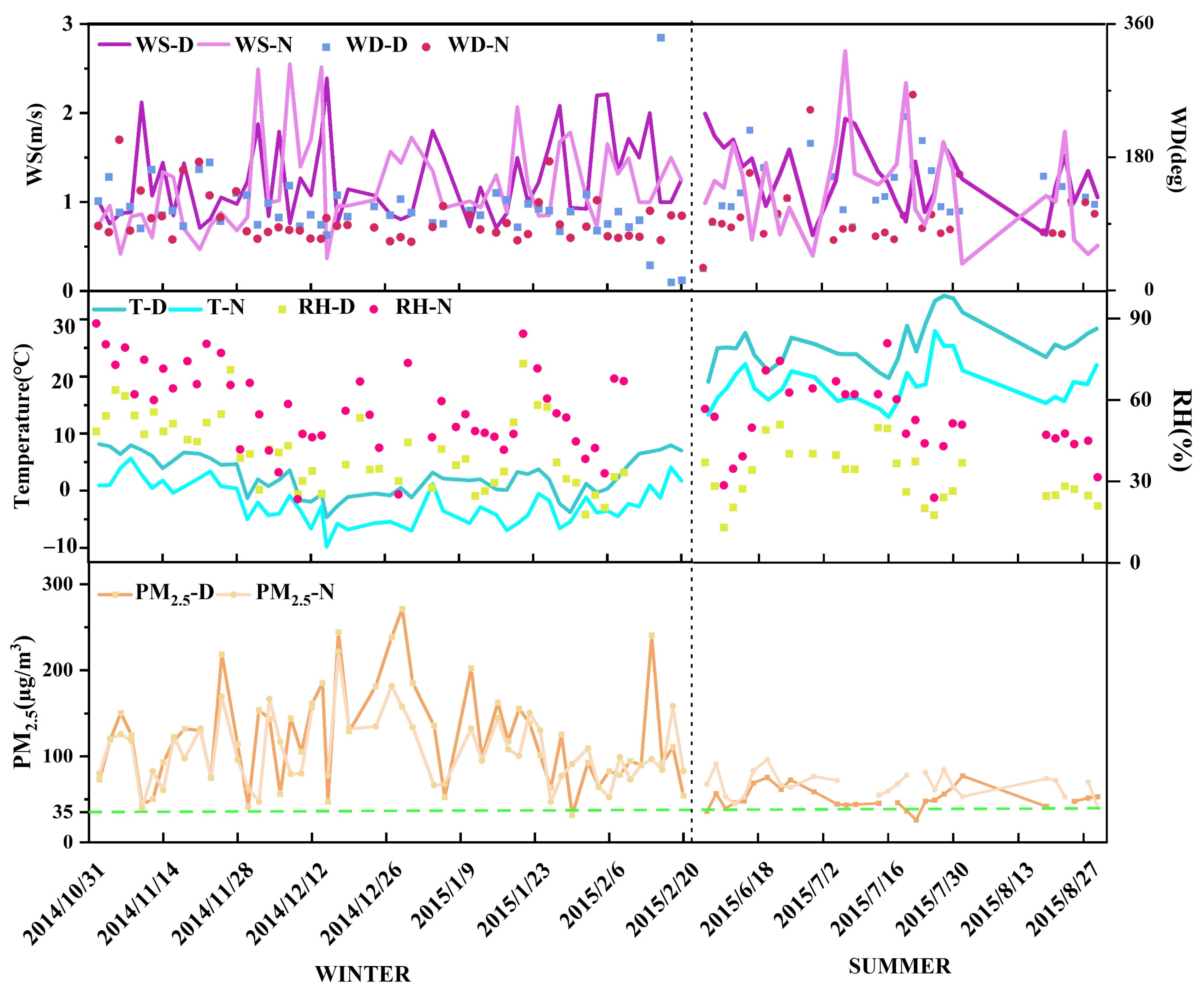
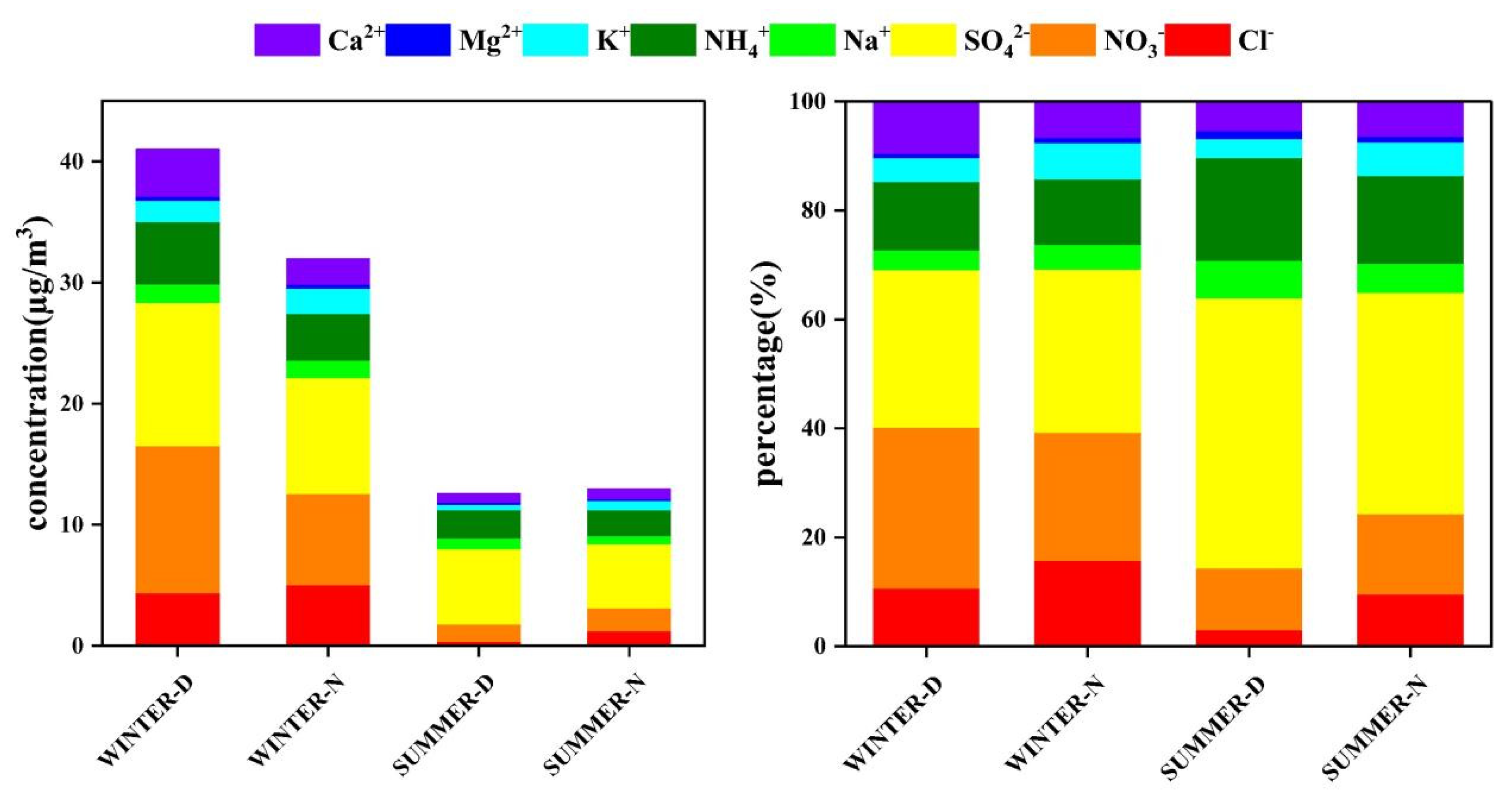
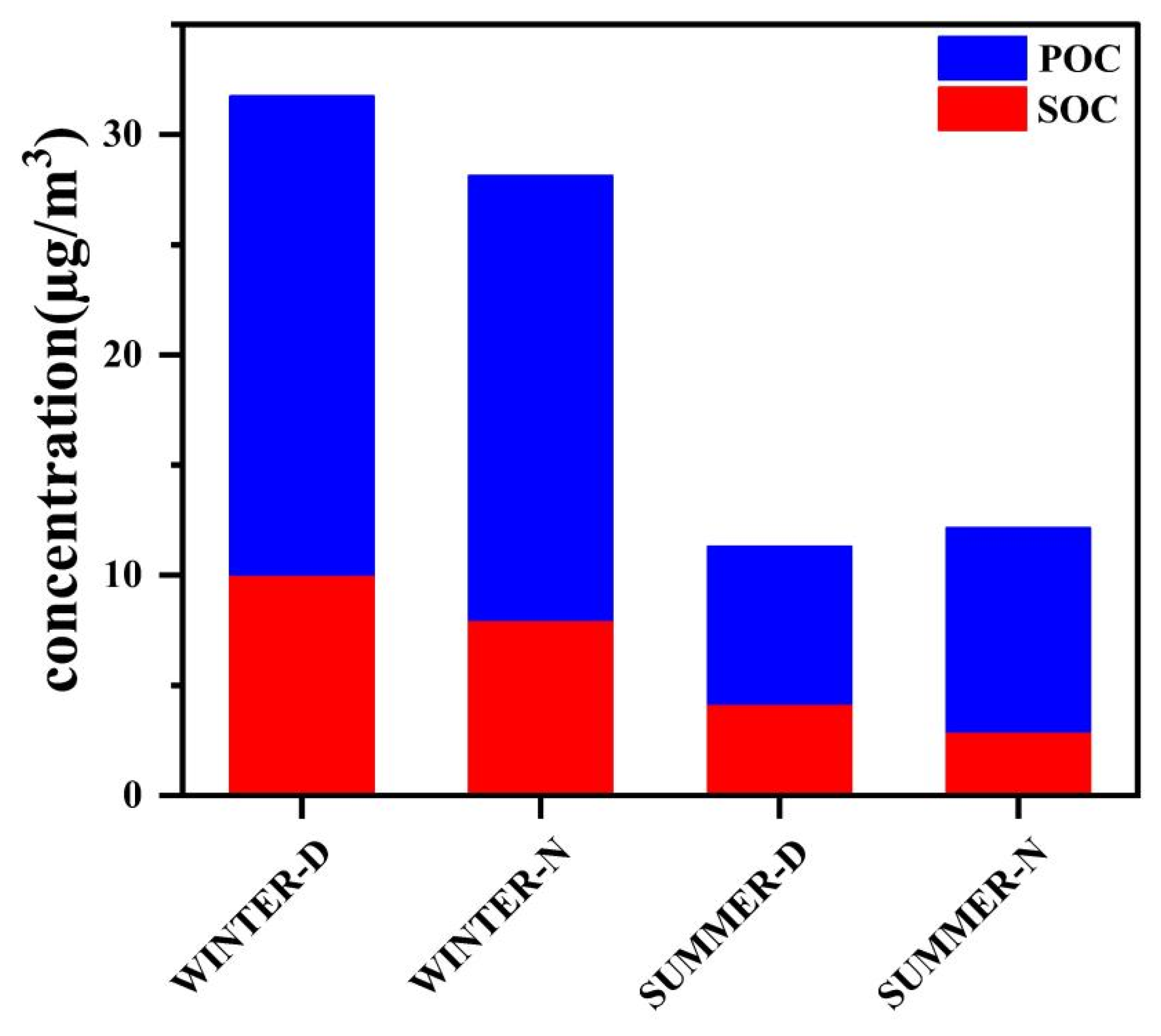
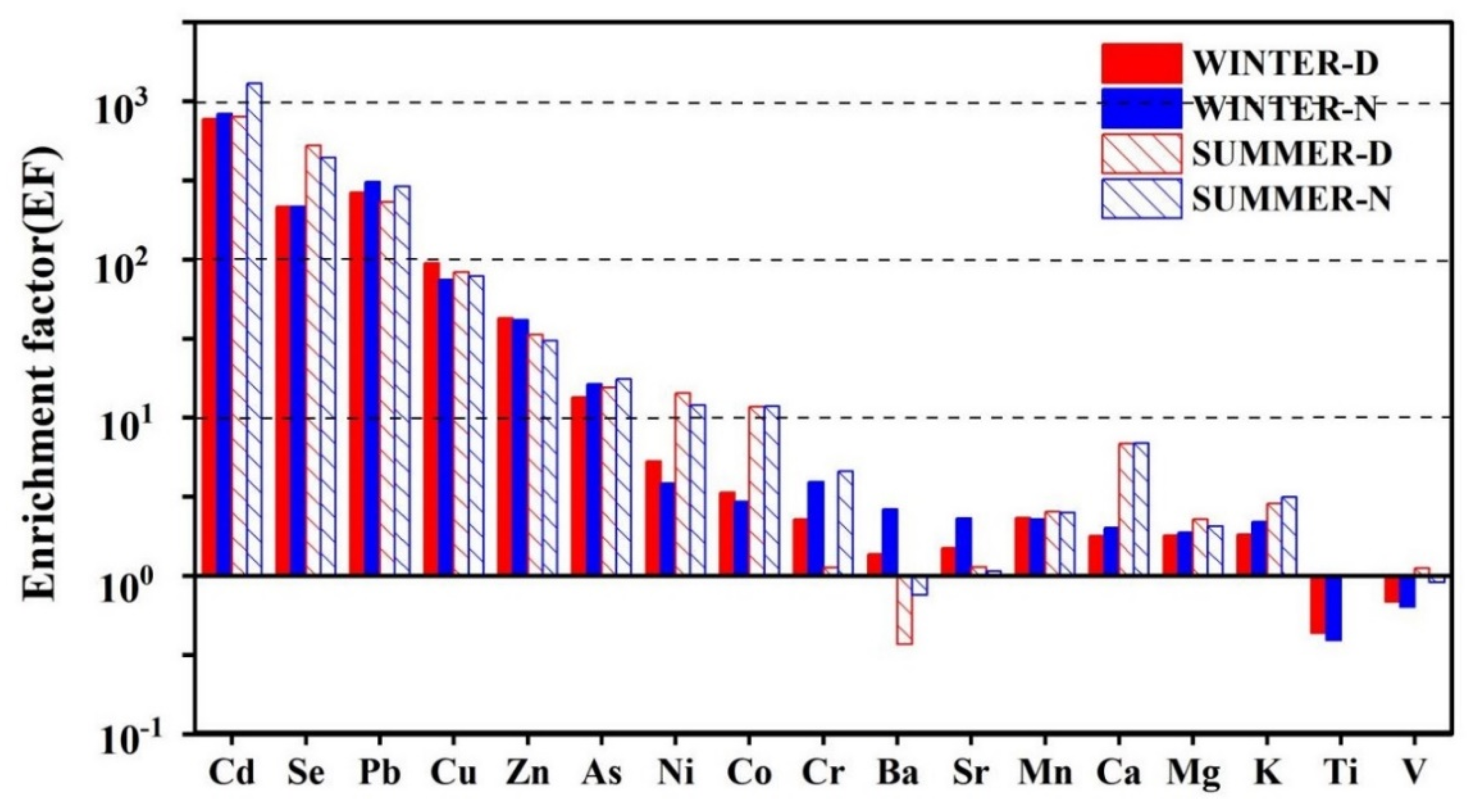
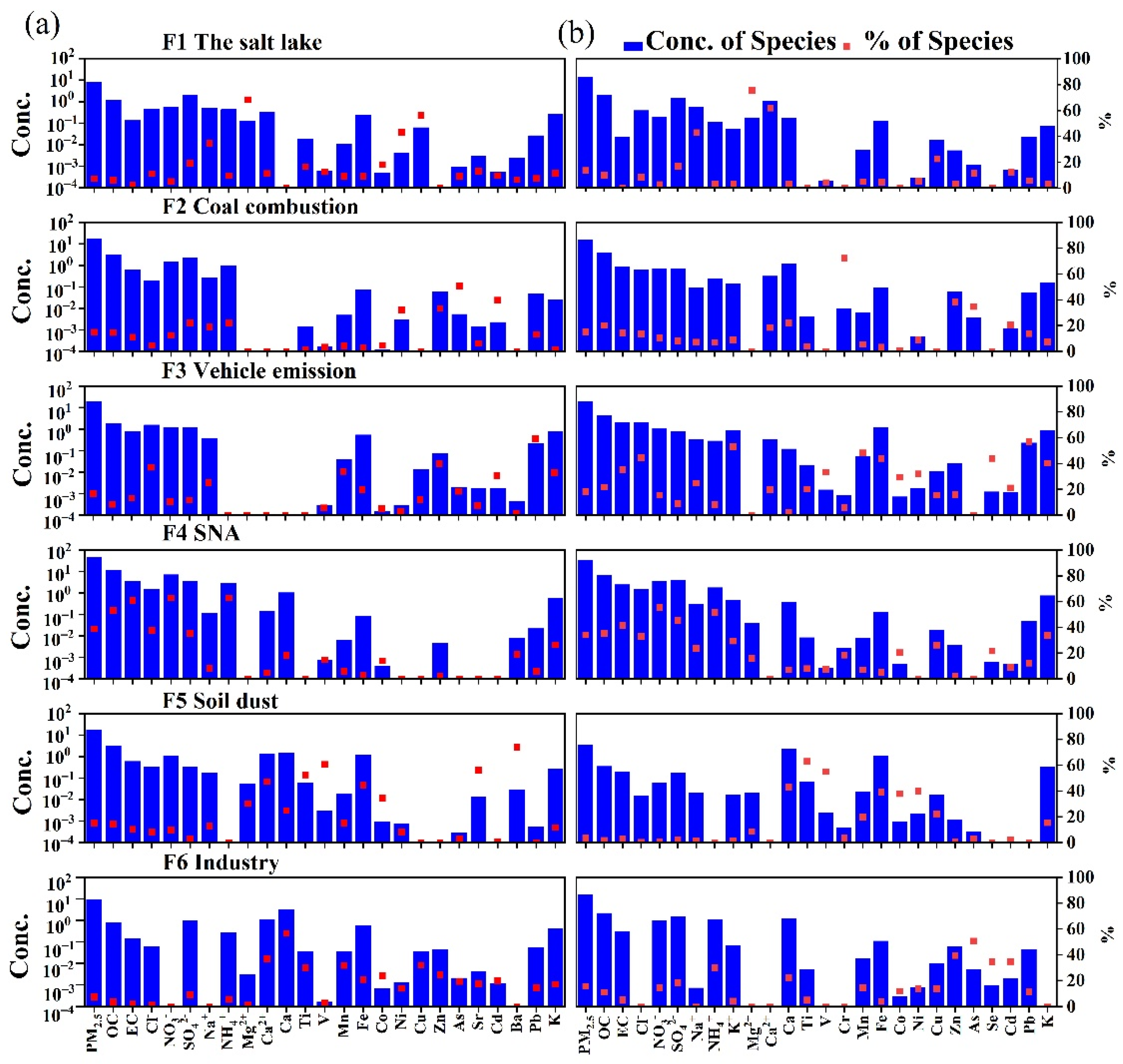
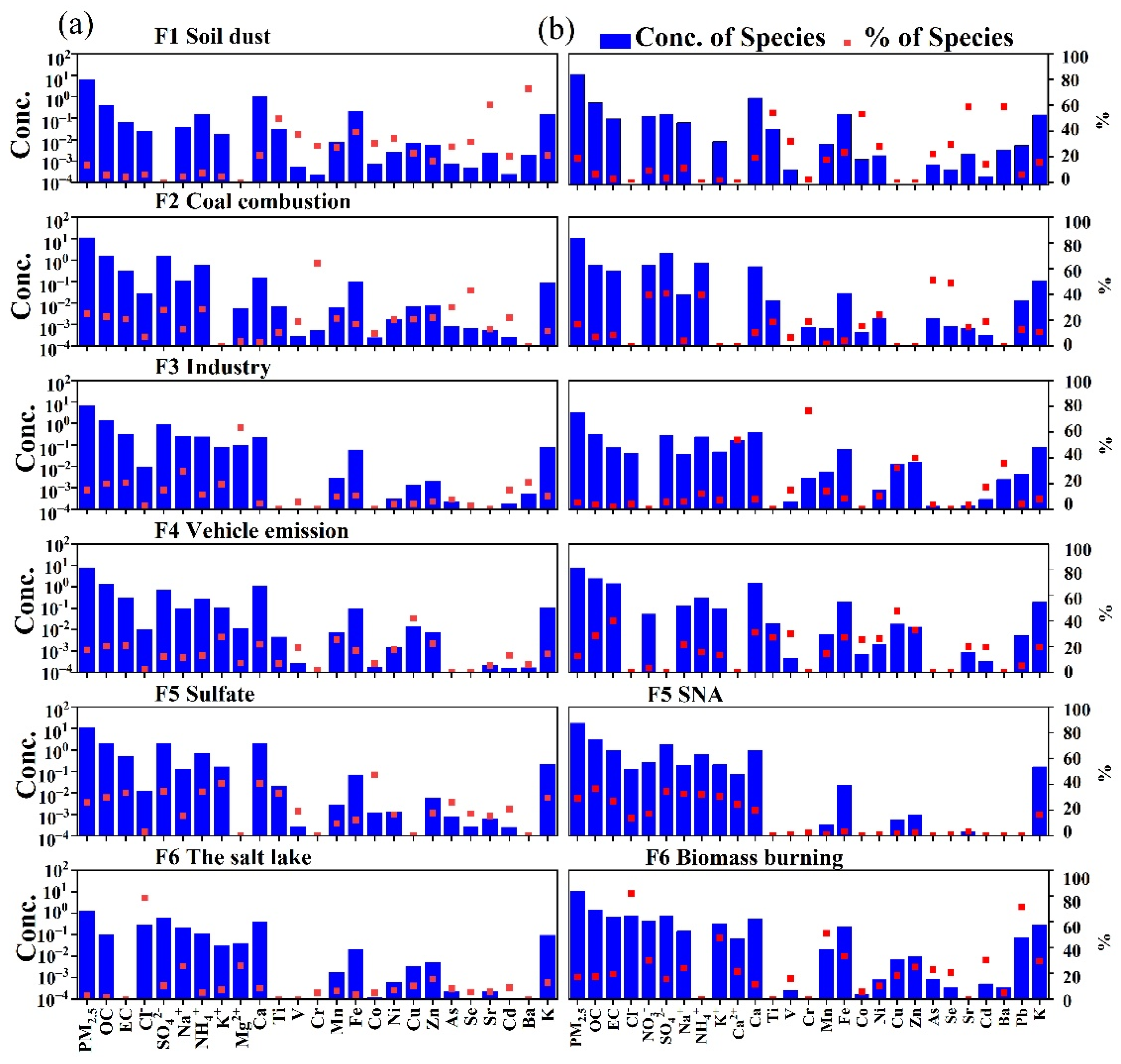
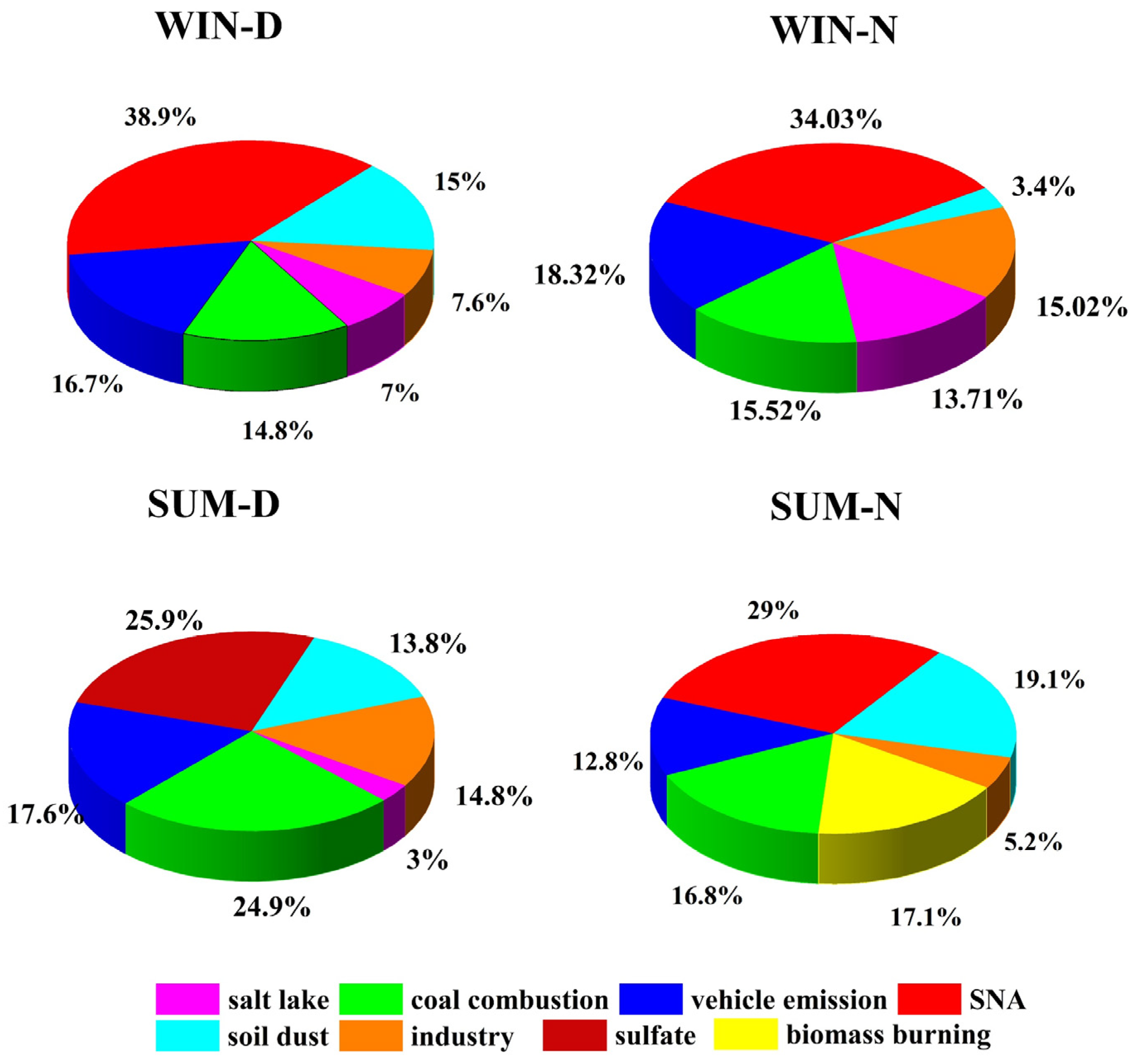
| Composition | Winter | Summer | ||||
|---|---|---|---|---|---|---|
| Day | Night | Average | Day | Night | Average | |
| PM2.5 | 122.55 ± 58.20 | 106.057 ± 39.500 | 114.39 ± 50.23 | 50.084 ± 120 | 66.008 ± 18.200 | 101.966 ± 37.800 |
| SO42− | 11.862 ± 6.000 | 9.583 ± 5.100 | 10.85 ± 5.65 | 6.23 ± 3.19 | 5.26 ± 2.47 | 10.34 ± 5.55 |
| NO3− | 12.118 ± 7.500 | 7.549 ± 4.800 | 9.99 ± 6.65 | 1.42 ± 0.69 | 1.92 ± 1.36 | 2.98 ± 1.95 |
| NH4+ | 5.134 ± 3.300 | 3.847 ± 2.200 | 4.55 ± 2.87 | 2.37 ± 1.17 | 2.09 ± 1.18 | 4.01 ± 2.21 |
| Ca2+ | 3.904 ± 2.700 | 2.111 ± 1.800 | 3.09 ± 2.47 | 0.67 ± 0.82 | 0.82 ± 0.76 | 1.33 ± 1.38 |
| Cl− | 4.392 ± 3.000 | 5.028 ± 3.200 | 4.77 ± 3.07 | 0.38 ± 0.55 | 1.24 ± 1.13 | 1.42 ± 1.30 |
| Na+ | 1.506 ± 0.800 | 1.438 ± 0.800 | 1.48 ± 0.78 | 0.86 ± 0.54 | 0.70 ± 0.25 | 1.40 ± 0.79 |
| K+ | 1.782 ± 1.200 | 2.111 ± 2.300 | 1.96 ± 1.82 | 0.44 ± 0.22 | 0.79 ± 0.55 | 1.09 ± 0.64 |
| Mg2+ | 0.328 ± 0.300 | 0.311 ± 0.400 | 0.32 ± 0.34 | 0.18 ± 0.24 | 0.14 ± 0.06 | 0.28 ± 0.27 |
| OC | 21.687 ± 11.000 | 20.132 ± 8.900 | 20.92 ± 9.99 | 7.262 ± 2.000 | 9.504 ± 3.600 | 14.941 ± 5.300 |
| EC | 6.066 ± 3.800 | 6.323 ± 3.500 | 6.19 ± 3.63 | 1.676 ± 0.500 | 4.116 ± 1.900 | 5.088 ± 2.500 |
| Ca | 5.828 ± 3.960 | 6.185 ± 3.952 | 6.00 ± 3.94 | 5.244 ± 1.615 | 5.474 ± 1.420 | 9.224 ± 4.019 |
| Fe | 2.885 ± 2.060 | 2.968 ± 2.229 | 2.93 ± 2.13 | 0.592 ± 0.235 | 0.811 ± 0.537 | 1.195 ± 0.778 |
| K | 2.559 ± 1.539 | 2.868 ± 2.868 | 2.71 ± 2.03 | 0.892 ± 0.373 | 1.192 ± 0.569 | 1.776 ± 0.960 |
| Ti | 0.131 ± 0.124 | 0.113 ± 0.098 | 0.12 ± 0.11 | 0.068 ± 0.044 | 0.072 ± 0.061 | 0.121 ± 0.102 |
| V | 0.005 ± 0.005 | 0.005 ± 0.004 | 0.010 ± 0.004 | 0.002 ± 0.001 | 0.002 ± 0.001 | 0.003 ± 0.002 |
| Cr | 0.010 ± 0.009 | 0.017 ± 0.015 | 0.01 ± 0.01 | 0.001 ± 0.002 | 0.005 ± 0.005 | 0.006 ± 0.006 |
| Mn | 0.126 ± 0.085 | 0.121 ± 0.079 | 0.12 ± 0.08 | 0.03 ± 0.008 | 0.044 ± 0.032 | 0.062 ± 0.039 |
| Co | 0.003 ± 0.002 | 0.003 ± 0.002 | 0.003 ± 0.002 | 0.003 ± 0.002 | 0.003 ± 0.002 | 0.005 ± 0.004 |
| Ni | 0.011 ± 0.006 | 0.009 ± 0.005 | 0.010 ± 0.005 | 0.009 ± 0.003 | 0.008 ± 0.003 | 0.015 ± 0.007 |
| Cu | 0.150 ± 0.131 | 0.117 ± 0.100 | 0.133 ± 0.117 | 0.035 ± 0.022 | 0.042 ± 0.031 | 0.066 ± 0.050 |
| Zn | 0.229 ± 0.201 | 0.182 ± 0.120 | 0.206 ± 0.167 | 0.041 ± 0.018 | 0.045 ± 0.032 | 0.074 ± 0.044 |
| As | 0.011 ± 0.006 | 0.011 ± 0.006 | 0.011 ± 0.006 | 0.004 ± 0.003 | 0.004 ± 0.003 | 0.007 ± 0.005 |
| Se | 0.003 ± 0.002 | 0.003 ± 0.003 | 0.003 ± 0.003 | 0.002 ± 0.001 | 0.002 ± 0.002 | 0.004 ± 0.003 |
| Sr | 0.025 ± 0.022 | 0.031 ± 0.053 | 0.028 ± 0.041 | 0.004 ± 0.003 | 0.005 ± 0.005 | 0.008 ± 0.008 |
| Cd | 0.006 ± 0.003 | 0.006 ± 0.003 | 0.006 ± 0.003 | 0.002 ± 0.001 | 0.002 ± 0.003 | 0.003 ± 0.003 |
| Ba | 0.053 ± 0.058 | 0.086 ± 0.224 | 0.069 ± 0.163 | 0.003 ± 0.004 | 0.008 ± 0.007 | 0.009 ± 0.009 |
| Pb | 0.404 ± 0.320 | 0.446 ± 0.341 | 0.425 ± 0.330 | 0.074 ± 0.039 | 0.139 ± 0.142 | 0.179 ± 0.157 |
Publisher’s Note: MDPI stays neutral with regard to jurisdictional claims in published maps and institutional affiliations. |
© 2022 by the authors. Licensee MDPI, Basel, Switzerland. This article is an open access article distributed under the terms and conditions of the Creative Commons Attribution (CC BY) license (https://creativecommons.org/licenses/by/4.0/).
Share and Cite
Zhang, M.; Jia, J.; Wang, B.; Zhang, W.; Gu, C.; Zhang, X.; Zhao, Y. Source Apportionment of Fine Particulate Matter during the Day and Night in Lanzhou, NW China. Int. J. Environ. Res. Public Health 2022, 19, 7091. https://doi.org/10.3390/ijerph19127091
Zhang M, Jia J, Wang B, Zhang W, Gu C, Zhang X, Zhao Y. Source Apportionment of Fine Particulate Matter during the Day and Night in Lanzhou, NW China. International Journal of Environmental Research and Public Health. 2022; 19(12):7091. https://doi.org/10.3390/ijerph19127091
Chicago/Turabian StyleZhang, Mei, Jia Jia, Bo Wang, Weihong Zhang, Chenming Gu, Xiaochen Zhang, and Yuanhao Zhao. 2022. "Source Apportionment of Fine Particulate Matter during the Day and Night in Lanzhou, NW China" International Journal of Environmental Research and Public Health 19, no. 12: 7091. https://doi.org/10.3390/ijerph19127091
APA StyleZhang, M., Jia, J., Wang, B., Zhang, W., Gu, C., Zhang, X., & Zhao, Y. (2022). Source Apportionment of Fine Particulate Matter during the Day and Night in Lanzhou, NW China. International Journal of Environmental Research and Public Health, 19(12), 7091. https://doi.org/10.3390/ijerph19127091





